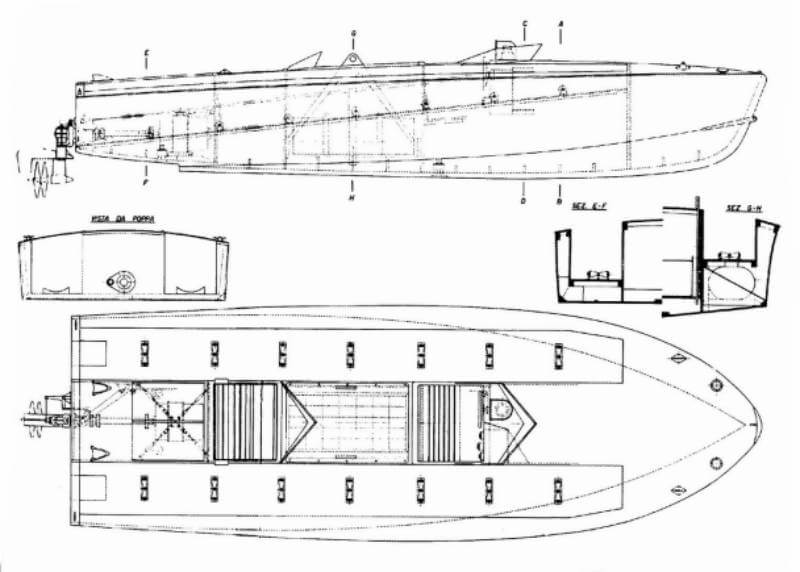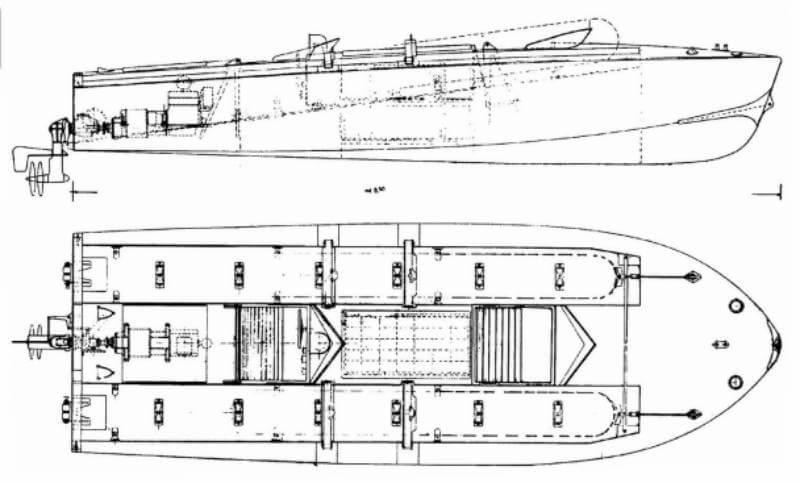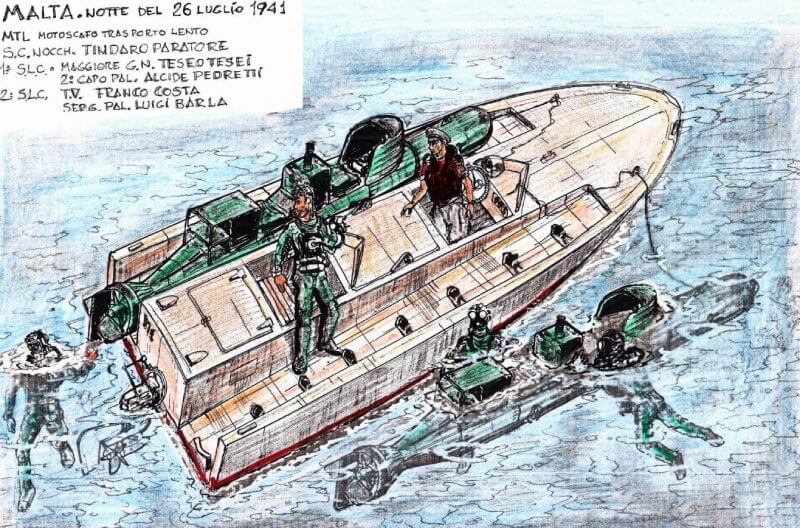| Length |
| 8.5 metres |
| Wide |
| 2.9 metres |
| Height |
| 1.45 metres |
| Displacement |
| 3 tons |
| Propulsion |
| A 22-hp twin-cylinder petrol engine and An 8-hp electric motor |
| Armour |
| – |
| Armament |
| – |
| History |
 |
The Motoscafo Turismo Lento, translating to ‘Slow Tourism Speedboat,’ is designed specifically for special operations. The hull mirrors the first series, but the propulsion system is customised for covert missions. They are manufactured by the two companies the Baglietto in Varazze (boat hulls) and CABI Cattaneo in Milan (machine parts).
The Motoscafo Turismo Lento was developed as a support vessel for the Siluro a Lenta Corsa, with twelve units constructed across three series between 1941 and 1943. These craft were assigned hull numbers between 400 and 600.
The first Motoscafo Turismo Lento, designed by Colonel Engineer Mizzau, entered service in late spring 1941. The initial series, based on CABI drawing no. A.429 dated February 16th, 1941, likely included two units. One participated in the ill-fated Malta raid on July 26th, 1941 and was reported missing after the operation.
Between early 1941 and September 8th, 1943, the Regia Marina ordered 12 Motoscafo Turismo Lento’s from CABI, with hulls supplied by Baglietto. Six were delivered before the armistice, while two were later supplied to the Repubblica Sociale Italiana’s Xa Flottiglia MAS unit. Two additional units were sent to Caproni in Milan, likely for modifications after 1943.
| Specifications |
Constructed with a wooden hull, the Motoscafo Turismo Lento measured 8.5 metres in length and 2.9 metres in width, with a depth of 1.5 metres. This design provided stability and seaworthiness, particularly in rough seas. The craft carried two Siluro a Lenta Corsa’s in an inclined position beside the cockpit, extending above the deck.
The hull featured a pronounced V-shape at the bow, gradually flattening towards the stern, disappearing approximately 1.3 metres from the transom. The forward cockpit was open, accommodating two crew members. The master steered from the left side, equipped with a wheel and compass in a faired binnacle, while the mission leader sat to the right at the instrument panel. Directly behind the cockpit was a 1.6 by 1 metre compartment, housing motor batteries, sealed by a removable hatch.or deploying divers, saboteurs, and spies beyond enemy lines following the Italian armistice.
Further aft, a compartment provided seating for the Siluro a Lenta Corsa operators. Positioned behind this section, an 8-horsepower electric motor drove the craft during stealth approaches, offering a range of 16 kilometres at 4 knots. The motor connected via a short shaft to the rudder-propeller assembly, which had a pronounced flap to improve manoeuvrability.
As the Motoscafo Turismo Lento was designed for short-distance operations, it lacked high speed or long-range capability. Larger vessels typically towed the craft to within striking distance of the target, lifting the stern drive to reduce drag. Small wave guards protected the crew compartments.
Each Motoscafo Turismo Lento featured two long recesses on either side (6.8 by 0.6 metres), where the Siluro a Lenta Corsa’s rested on inclined saddles fitted with seven pairs of rollers, facilitating gravity launches. Transom openings at the stern could be sealed with removable panels. The hull included four bilge pumps and two perforated metal plates with brackets inside the central bulkheads for attaching lifting cables.
The Baglietto Shipyard in Varazze (Savona) constructed the hulls, with fitting and installation of motors and instruments by CABI. Although records for the second series are scarce, they were believed to be similar to the first.
The third series, as detailed in CABI drawing no. A.440 dated January 21st, 1942, introduced several design changes. Hull dimensions remained largely unchanged at 8.5 by 2.85 by 1.45 metres. However, crew compartments were reversed, positioning the Siluro a Lenta Corsa operators at the bow and the master and mate at the stern. The steering wheel remained on the left, but the compass was relocated to the centreline for better visibility.
The side recesses for Siluro a Lenta Corsa’s remained, though the rollers shifted sternwards, allowing the rear roller to protrude from the transom, easing launch. The Siluro a Lenta Corsa’s were secured by cables attached to deck eyebolts and two foldable collars with screw handles.
The propulsion system underwent significant modification. The third series featured a petrol engine alongside the electric motor, both connected through a reduction gear and integrated reverse system (CABI drawing no. A.424 dated March 2nd, 1942). The petrol engine produced 22 hp, while the electric motor retained 8 hp. The craft achieved a top speed of 5.5 knots using the petrol engine and 4 knots under electric power. The range extended to 97 kilometres at 5 knots.
The petrol engine operated at 3,200 rpm, driving the propeller at 730 rpm, while the electric motor peaked at 2,500 rpm (570 at the propeller). The system allowed fine adjustments, with the electric motor reducing to 1,500 rpm for 3 hp output during final approach.
Transmission ratios were 1.56 for the main shaft and 2.85 for the reducer, yielding a total reduction of 4.41. The two-cylinder, seawater-cooled petrol engine featured a front radiator and small muffler, with an exhaust manifold on the starboard side. A clutch on the left allowed the electric motor to disengage or operate independently.
For maintenance, the propulsion system was housed in a well beneath a removable cover. The propeller-rudder assembly lifted to starboard, providing a rudder angle of up to 20 degrees in either direction. Four lifting points, positioned near the crew compartments, facilitated handling.
The total weight of the Motoscafo Turismo Lento at full load was approximately 7,300 kilograms. CABI archives reference a larger Motoscafo Turismo Lento variant, measuring 10.72 metres but maintaining the same width and weight, capable of transporting the newer Siluro San Bartolomeo.
| Operational Use |
As of October 20th, 1942, five Motoscafo Turismo Lento’s were operational with six under construction. Despite their limited numbers, Motoscafo Turismo Lento’s saw action in various missions:
- Malta Raid (July 26th, 1941): One Motoscafo Turismo Lento, commanded by Leading Seaman Tindaro Paratore, transported the Siluro a Lenta Corsa’s of Tesei and Costa. After the operation failed, the craft was scuttled to avoid capture.
- Livorno Operation (November 7th, 1944): MTL 476, commanded by Lieutenant Uras, carried Siluro San Bartolomeo’s and munitions but aborted the mission due to overheating.
| Multimedia |




| Motoscafo Turismo Lento |


